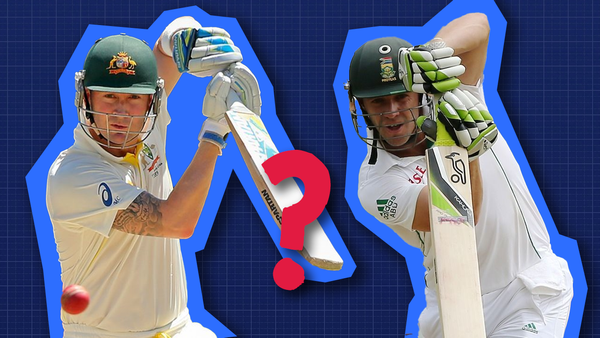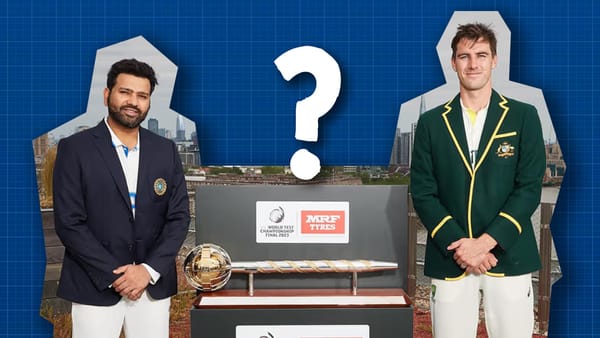New Zealand finally win in India
They had been coming to India for almost 40 years to lose. This time, they won.

Ajaz Patel was the only New Zealand player alive the last time they went to India and won a Test match. That is an entire generation of pretty good cricketers travelling to India and losing. There is no doubt that the conditions played a part on day two, but so did New Zealand's fielding and Rachin Ravindra's counter attack with the bat. So to throw this win away as a fluke of the Bengaluru rain is unfair. Let's be honest, New Zealand have been coming to India for almost 40 years—to lose.
I'm still trying to wrap my head around the last few weeks of international cricket. Remember, Bangladesh went to Pakistan and won the series 2-0. India then made a Test match result out of nothing more than will and intent. England beat Pakistan by an innings after the hosts scored 556 runs in the first innings, and then lost the next Test. Women's cricket has had two incredible upsets, and maybe the most unlikely final pairing that we would ever see.
New Zealand bowled India out for 46, had a 356 run lead, and it still felt like they might lose the game. In fact, they have been travelling to India for a very long time and not winning. To go up against such an incredible home team when your side is in transition, and your captain has just given up his position recently means that you think it would be even less likely that they were going to break their winless streak in India.

And of course, New Zealand are uniquely set up to lose in India. They have had Daniel Vettori and John Bracewell, and not a lot of spinners other than them. Even when New Zealand have a good spinner, they usually only have one.
If New Zealand are not the worst spin bowling country, then they are certainly in the conversation.

In fact, if New Zealand are not the worst spin bowling country in Asia, then I still think they are very much in that conversation.

And if New Zealand are not the worst spin bowling country in India, then again, they are in that conversation.

Look at New Zealand versus Indian spinners in the same matches. There is quite clearly a difference here.

However, I don't just want this to be about their bowlers because I think that would be very unfair. New Zealand batters have also not been particularly good.
This is a collection of teams and how they've gone in terms of win percentage in Asia. You will notice is that some of these teams actually have a lot of good players of spin.

West Indies have produced Garfield Sobers, Viv Richards, Brian Lara, and Shivnarine Chanderpaul. Australia’s lineup included Mike Hussey, Neil Harvey, and others who handled spin well. England, with Joe Root at present, also has a long history of excellent players of the turning ball. South Africa has seen Smith, Kallis, and Amla, all skilled at playing spin.
That list is really short when you start thinking about New Zealand batters against spin. They just don't have that level of batting to fall back on. So it means that when they're in Asia—or specifically India—they don't have the amount of runs that they can put pressure back on the opposition. And then they can't take any wickets because if they have one good spinner, they probably don't have two, and almost certainly never have three.

In India, all of this plays out. West Indies have always been a very good team when they've travelled to India. Australia have been very dominant elsewhere and not as dominant in India, but they have been able to get regular wins. England have had some periods where they've played some very good cricket there. Pakistan have had a lot of draws in India, but they've also won a series over there.

Then you've got New Zealand. Of course, India being the best at bowling spin and the best at playing spin—sometimes simultaneously—plus having wickets that really, really spin means New Zealand are touring with this incredible natural disadvantage.
New Zealand is a historically terrible place to bowl spin. However, Australia, West Indies and Pakistan are all worse, but they have produced better spinners and better players of spin. Perhaps average isn't the best way of looking at it.

It's maybe more to do with how little spin is bowled or played within New Zealand. It is very hard to get better at it, if you're never bowling or facing it.

So everything I've just told you is exactly what you know. New Zealand has not played spin very well. They have not found many spinners. When they go to India, they have to come up against both of those issues. And it's not just India, they're also not very good in Asia.
However, this Test wasn't like that. This was a seam friendly wicket. In fact, at some stages, the ball was swinging. Other times, it was seaming. It had extra bounce. There was even a little bit of lower bounce. There were so many things going on for the seamers in this game.

Sometimes you get wickets like that in India. It's not as if seamers never get anything out of these wickets. But what is rarer is to have a wicket that is heavily weighted towards seam bowlers getting wickets and not spin bowlers. Usually when the quicks are doing well in India, the spinners are still handy—and sometimes even more than handy—and they can be just as good.
In this match, if you bowled seam up, you were brilliant. If you tried to spin the ball, you were ineffective.

But not only did the spinners not take any wickets, they also went at 1.72 runs an over more. They were getting absolutely hammered. Bowling spin on this wicket didn't help all that much.

Remember, New Zealand had three seamers and two spinners. India had the opposite of that. We don't have Hawkeye data and ball-by-ball records all the way through, but I'm going to go out on a limb and say this is the most seam-friendly wicket that New Zealand have ever had while touring India.
In 1969, they won a Test in India. At the same time, they won a series in Pakistan. So we know they were pretty good touring side in Asia in that period.
When you check the scorecard of the Test that they won, it was their spinner Hedley Howarth, who had completely outshone their seamers—even Bob Cunis.
In 1988, they upgraded from Cunis to Richard Hadlee. Hadlee took a six-wicket haul—as was the law—because he had to take wickets in pretty much every game he played. But the Player of the Match was their spinner, John Bracewell. Other than Hadlee, if you have a look at the whole scorecard, a lot of wickets were taken by spinners.
So I think we could safely say that this was the most movement off a pitch that New Zealand seamers have ever had in India, without any added data needed. Plus, it also swung and there was variable bounce. Not to mention that Rishabh Pant hit a six so big that he actually found a magic ball for New Zealand. These were ideal conditions when you have an extra seamer in your attack and when you have a couple of hit the wicket bowlers in Henry and Will O'Rourke.

And there's absolutely no doubt that a lot went their way. For instance, Tom Latham said that he would have batted first if he had won the toss.
A lot of people are saying that Rohit Sharma made a huge mistake, but the truth is no one thought this wicket was going to be anything like that. Rohit was unlucky with the toss, but also because they were missing an extra seamer meant it was even more unlucky.
There will be people pointing to Rohit's overall captaincy. I don't think once you take the toss away, it was that bad. But there were a couple of really interesting decisions. The fact that he didn't use Jasprit Bumrah when Tim Southee first came to the crease, and he seemed to have to misplaced Ashwin during the fourth innings. There is simply no other way of putting it than a lot of things went New Zealand's way.
New Zealand have spent decades and decades coming to India and getting nothing, and are now playing one of the greatest and most unique touring challenges that has ever existed in cricket. They had two awesome days where you're bowled India out for 46, you have a 356 run lead and Tim Southee outscoring the opposition entirely.
Yet late on day four, you are still somehow in a dogfight, and India are back in front. Literally in terms of runs and figuratively in terms of the game. So from that point forward, New Zealand had to overcome set Indian batters, a long batting order, Jasprit Bumrah hooping the ball around, Jadeja out of the footmarks and about 40 years of depressing history.
New Zealand sent a better team to India a three years back, and all they got was a last ball draw. This team is in development and it just took a Test win with eight wickets to spare. They had been coming to India for almost 40 years to lose. This time, they won.




